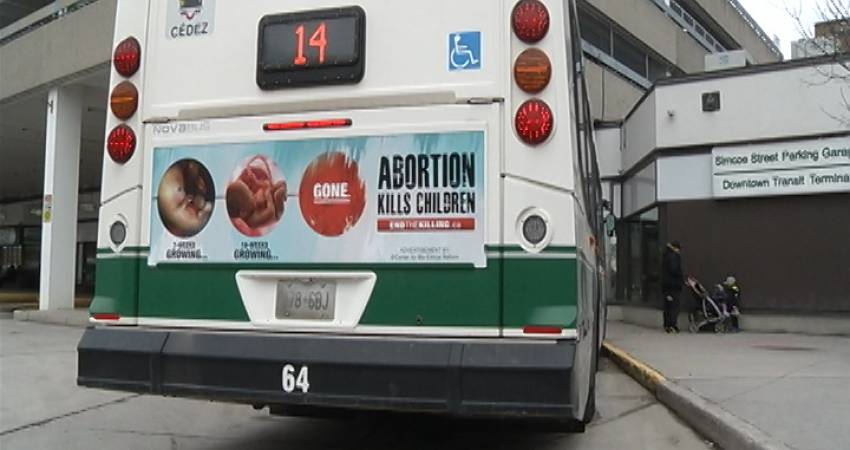
According to pro-aborts, even pictures of babies in the womb are 'graphic images'
Pro-lifers uncomfortable with most forms of educational outreach often pinpoint their discomfort very specifically on one thing: Abortion victim photography makes people upset. There are a variety of responses to this, of course—images of abortion victims should make us upset, because little human beings are being physically torn limb from limb. But often, I point out the fact that regardless of whether we choose to use photographs of abortion victims in our outreach, people will always get upset, and they will always accuse pro-lifers of being extreme. It is the truth that we bring that upsets people, not the method we use to bring it. That’s why pro-lifers have been attacked at Life Chain, while sidewalk chalking, and virtually any other form of outreach you can think of.

Let me give you one example. Recently, the city of Peterborough reluctantly allowed the Canadian Centre for Bio-Ethical Reform to run pro-life ads on the backs of city buses (they will be running for the next three months.) This is how the Peterborough Examiner covered the story:
A plan from city council to make changes to their advertising policies to prevent a pro-life group from ever running pro-life ads on public transit – with graphic images of fetuses – was ratified by council on Monday night, even after several women told council they failed by not blocking the ads in the first place.
Two ads are coming to public transit this week – likely Tuesday. They come from the Canadian Centre for Bioethical Reform, and they feature graphic images of aborted fetuses.
There’s one problem with that description: Our ad does not include any photographs of aborted babies. It simply shows two photographs of children in the womb followed by a blank red circle, with the words “Growing, Growing, Gone” beneath them.
A photo of the ad was included in the story that made this claim, so the journalist writing the story obviously knew that she was misrepresenting the advertisement. She also twice referred to the images as “graphic images of fetuses” and quoted a post-abortive woman who complained that the images were “spewing bigotry.”
So it turns out that even photographs of healthy human babies are now “graphic images,” simply because the reminder that babies do, in fact, grow in the womb is discomfiting to a society that is determined to deny them their rights. In January, the Peterborough Examiner referred to the ad as a “graphic anti-abortion ad.” The same characterization was used by Kawartha News:
In January, at the request of Councillor Dean Pappas, council asked for City staff to report back on , one, options to adjust the city-wide advertising policy to ensure harmful messages are not allowed on city property, and, two, the municipality’s legal options to prevent the display of graphic images on public transit.
Again, there it is—simple photos of human beings developing in the wombs of their mothers are considered “graphic images” by the pro-abortion media. And earlier today, Justin Trudeau’s Minister of the Status of Women Maryam Monsef—who recently proclaimed that lack of access to abortion was a human rights violation—took to Facebook to condemn CCBR’s ad and say the same thing:
Many residents have recently shared with me their displeasure that graphic anti-choice advertisements are now appearing on Peterborough transit. First of all, I want to commend all of those who have been engaging respectfully in this conversation about a difficult topic…
While the federal government cannot take actions to stop or mitigate these ads in their current configuration, anyone who is concerned may want to consider contacting Advertising Standards Canada, which is a national not-for-profit self-regulatory body for advertising in Canada.
Pro-lifers have to realize something: Abortion supporters are always going to claim that we are extreme because they despise our simple message of human rights for all human beings.

If we use photos of aborted babies as evidence in the court of public opinion, they announce that such pictures are “too graphic.” If we use photos of healthy babies in the womb, they report that we are using “graphic images.” If we show people what happens to three hundred pre-born children in Canada every day, they accuse us of using hateful imagery. If we show them blissful, happy images of pre-born children, we are “spewing bigotry.” It doesn’t matter what method pro-lifers use.
At the end of the day, we are telling a culture that kills its children what happened to those children, and they are not going to be happy with that. Confronting the culture is a difficult thing to do, but it must be done. In the meantime, I’m not going to take pro-life strategy cues from people who want abortion to remain legal—and even think photos of babies in the womb are “too graphic.”
Printed with permission by Jonathon Van Maren and published first here
Featured
- Campaign to stop EU funding out of state abortions - tell your EU commissioner to vote NO
- Judge recuses himself from case of woman praying in censorship zones for “apparent bias”
- I’m a Celebrity star criticises “sad” UK law that aborts babies with Down Syndrome up to birth
- British actress speaks out on “serious risk” assisted suicide bill has for those with eating disorders
- Caplan’s “Tragic Hysteria of Abortion” discusses the flaws with mainstream Turnaway Study interpretations
- Backlash as Scotland report proposes legalising sex-selective abortion up to birth
- Canada hits new record as 1 in 20 deaths a result of Euthanasia
- Ben Scallan defends pro-life on TV show Dinner with the Enemy
- Influencers share the loss of their beloved unborn baby
- Dublin woman with cancer says unborn child was sent to save her
- Mother and baby doing well after surgery for mother’s cancer during pregnancy
- Josiah: Abortion Survivor
- Loving the Unborn
- Rally for Life 2025
- Don't assist Suicide 2024


























